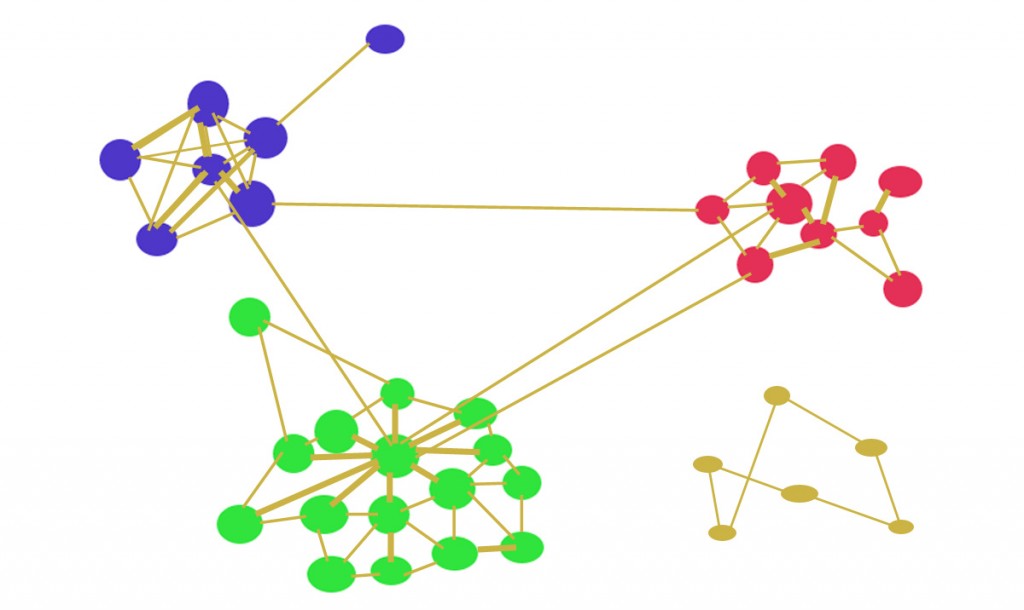Guest Writer for Wake Up World
I read a beautiful quote on Quora the other day, from a five year old. Her father had asked “How do we show someone we love them?”, and she responded “We play with them.”
I love it! We sing, dance and play! Sometimes we play hard.
When we love, we are strengthening our communities.
Communities, as defined by the healthicine hierarchy, cover a wide range, from couples, to families, to partnerships, companies, corporations, churches, and governments. Any group of people. Even people and animals living or working together.
Communities, healthy communities, can be competitive, cooperative, or even playful. Some communities are very well connected, others poorly connected to their members – and to other communities. Some communities are very rich, complex, complete and healthy. Some communities are very hierarchical, others are more egalitarian. Others are very thin or poorly connected. Each community is unique.
Can We Measure Community Healthiness?
How can we tell if a community is ‘healthy’? What are the dimensions of community healthiness?
As I mentioned, some communities are very well connected, others less so. Some communities are very complex and rich, some hierarchical, others are more egalitarian. Some are poorly connected. If at all.
This image illustrates the the nature of ‘community’.
In his book The Advantage: Why Organizational Health Trumps Everything Else in Business, Patrick Lencioni provides a very interesting set of concepts relating to ‘organizational health’. Organizational health, according to Patrick, is about integrity. “An organization has integrity – is healthy – when it is whole, consistent and complete…” He also noted that some conflict is healthy (‘no conflict’ is unhealthy), as is some confusion, and also some turnover in membership.
Is this how we can measure community healthiness?
Communities, in healthicine, are a much broader concept that Patrick Lencioni’s organizations. Patrick’s interest is in helping organizations – companies and corporations – to be healthier and thus more profitable. But this view does not consider the interactions between organizations, which are often unhealthy by design. Companies and corporations are often in competition. Communities are sometimes cooperating, sometimes competing.
When we look at the hierarchy of healthicine, it’s not difficult to imagine measures of healthiness for our diet, our organs, our bodies, even our minds. So how might we identify, and work to improve, the healthiness of our communities?
Every community also has ‘community’ aspects. Some communities might be very inclusive, others very exclusive – some competitive, cooperative or playful. This reflects the community’s link back to its individual members. When we look at Patrick Lencioni’s measurements, some communities might be very sound, whole, consistent and complete, while others might be unsound, inconsistent and incomplete.
In the Garden
Let’s look at the nature of community.
Adam lived alone in the garden of Eden. His constraint consisted of one rule from his God. You must not eat from the tree of knowledge. God made no other requests, no other rules. Adam had no needs that were not met by the garden, and thus no need to make requests of God. Was it possible for Adam to love? Was it possible for Adam to sin – alone in the garden? Let’s consider sins first.
The Ten Commandments:
Thou shalt have no other gods
Thou shalt make no graven images or likenesses
Thou shalt not take the LORD’s name in vain
Thou shalt remember the Sabbath day
Thou shalt honour thy father and thy mother
Thou shalt not kill
Thou shalt not commit adultery
Thou shalt not steal
Thou shalt not bear false witness
Thou shalt not covet…
Adam had no other gods. Thus no need for graven images or likenesses of his Gods. In the garden, all of his needs were met, thus there was no need to take his LORD’s name in vain. There was no Sabbath day, no need to remember. No need to rest or recover from and reflect upon his sins.
No father nor mother to dishonor. No-one to hate or kill. No-one to commit adultery on, or with. No-one to steal from. No-one to bear false witness against. No-one to be jealous of.
Because Adam had no community, he could not sin. Or could he? What about the Seven Deadly Sins: Lust, Gluttony, Greed, Sloth, Wrath, Envy and Pride?
Lust – not possible without a community. Gluttony? “it is considered a sin if the excessive desire for food causes it to be withheld from the needy” – not possible without a community. Greed – not possible without a community. Sloth? “failure to utilize one’s talents and gifts” – to what end could Adam utilize his talents and gifts with no community to benefit from his work? Wrath – against whom? Envy – of whom? Pride – who could Adam demonstrate ‘pride’ to, if there is no community.
Sins are not judged as sins without a community to pass judgement. It was not possible for Adam to sin.
Adam, alone in the garden of Eden, was also not capable of representing the Catholic Seven Virtues, which are the opposite to the seven sins: Chastity, Temperance, Charity, Diligence, Patience, Kindness, Humility – except perhaps with regards to the other animals in the garden. There were no people to be kind to, no poor to be charitable to, no disruptive people to be patient with, no children to try his diligence or kindness.
We might also ask, did Adam love the garden? Did he love the animals? The trees? Did he love his God? I don’t believe the concept of love existed until the arrival of Eve, until the arrival of a community.
Love, like sin, requires community. Love is an aspect of community healthiness. As is hate. In the garden of Eden, without a community, it was not possible for Adam to love. When Eve arrived, Adam became part of a community, and it was possible to sin, it was possible to be virtuous, and it was possible to love.
Every community creates demands on individuals. Even with only two individuals – maybe one wants to be in the sunshine, when the other wants to be in the shade. But both want to be together. Conflicts arise naturally, and because there is a community – these conflicts can be dealt with, or not, can grow, or fade. The serpent arrives, and makes suggestions, which create more conflict. The community has grown. God, Adam, Eve, and the serpent. So far, only one rule, in theory, one ‘restriction of freedom’. Don’t eat from the tree of knowledge.
Once Adam and Eve ate from the tree, their families, and their communities grew. It wasn’t long before Cain killed Abel. Murder, is a symptom of community illness, not possible when Adam was alone in the garden. Murder is only possible in a community.
As an aside, we can also see that, until there was a community, Adam had no concept of ‘freedom’, because there was no community to constrain him. Is it possible to have ‘freedom’ without the existence of constraints? As our communities grow, and grow more complex, the line between sins and virtues is not so simple. Is it possible to experience freedom, if it is not possible to make our own judgements, decisions, and choices between sins and virtues?
In the garden, communities were very simple – families, and then tribes. But today, we have communities, of communities, of communities. Our communities, and many layers of communities interact, as well as some communities (corporations) that are ‘legally’ recognized – but who cannot ‘sin’. If we are to improve the healthiness of our communities, including corporations, we need to recognize that community creates ‘sin’, and that to be healthy, communities must strive to be virtuous. But today, the openly displayed goals of many of our ‘communities’ – corporations – include greed, envy, pride, wrath, and gluttony… and this is an unhealthy shame for all of us.
We know that communities can tout their virtues. But can a community confess its sins? Maybe it’s time to expand the confessional.
Sing! Dance! Play! When we love, we strengthen our communities.
To your health, Tracy
Updated September 2014
Previous articles by Tracy Kolenchuk:
- Body, Mind & Spirit: Understanding the Links Between Health & Consciousness
- Curing Cancer Requires a New Kind of Thinking
- 10 Common Nutrition Myths and Misconceptions
- A Scientific Theory of Illness
- Why Is Obesity Associated With So Many Diseases?
- The Medicines Myth
- The Alternative Medicines Myth
- Fatergy Drinks: The “Energy Drink” Myth De-Bunked
- Are You Getting Enough Vitamin M?
- Generic Cancer (Part 4): The End of The War on Cancer
About the Author:
Canadian born Tracy Kolenchuk is the author of A New Theory of Cure and several other books.
Tracy is not a doctor. He is the founder of www.healthicine.org and www.personalhealthfreedom.blogspot.com where he works to change the way the world defines and looks at health, healthiness, healthicine, disease, and cure.

If you've ever found value in our articles, we'd greatly appreciate your support by purchasing Mindful Meditation Techniques for Kids - A Practical Guide for Adults to Empower Kids with the Gift of Inner Peace and Resilience for Life.
In the spirit of mindfulness, we encourage you to choose the paperback version. Delve into its pages away from screen glare and notifications, allowing yourself to fully immerse in the transformative practices within. The physical book enriches the learning process and serves as a tangible commitment to mindfulness, easily shared among family and friends.
Over the past few years, Wake Up World has faced significant online censorship, impacting our financial ability to stay online. Instead of soliciting donations, we're exploring win-win solutions with our readers to remain financially viable. Moving into book publishing, we hope to secure ongoing funds to continue our mission. With over 8,500 articles published in the past 13 years, we are committed to keeping our content free and accessible to everyone, without resorting to a paywall.








